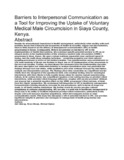Barriers to Interpersonal Communication as a Tool for Improving the Update of Voluntary Medical Male Circumcision in Siaya County, Kenya
Date
2020-03-31Author
Osir, Otteng
Wenje, Peres Nyawanga
Kiptoo, Michael
Metadata
Show full item recordAbstract
Despite its acknowledged importance in health management, particularly when dealing with such sensitive issues that transcend the boundaries of health as sexuality, stigma and discrimination, there is little research on the efficacy of interpersonal communication (IPC) in health programmes in Kenya. Consequently, little is documented on barriers to IPC in the implementation of health interventions. We examined specific potential barriers to IPC as an integral device in the implementation of the voluntary medical male circumcision (VMMC) programme in Siaya, Kenya. We used a mixed-methods sequential cross-sectional research design, and the multi-stage sampling technique – combining purposive and chain referral sampling procedures to arrive at the desired samples. Two questionnaires were administered on 370 male residents of Bondo and Rarieda in Siaya; and on 35 implementers of the programme in the two sub-counties. Further, we interviewed five managers from the implementing agencies. We used descriptive and inferential statistics to analyse quantitative data, and presented the findings through text and tables, while qualitative data were analysed through the description, analysis and interpretation process. The findings show time constraints as a significant barrier chiefly from the viewpoint of the operational staff, who admitted lacking time for meaningful interactions with their clients to fully explain issues raised for desired mutual understanding. Culture, in its various forms, has a significant negative cross-cutting bearing on provider-client interactions, while provider-client language difference, coupled with service providers’ attitude and jargons had a potential negative effect on the VMMC programme’s final outcome, at least from the clients’ perspective. We recommend full integration of IPC in healthcare management. Communication training should be accorded its due prominence, both in terms of scope and depth, in all heath training institutions. We further vouch for service provider cultural competence to enhance understanding. IPC can play a crucial role in healthcare management in Kenya due to its ability to facilitate important provider-client transaction, particularly in the largely oral rural resource-deprived populations, which lack adequate access to mass communication media. This study has discussed a raft of potential barriers to IPC, and provides significant insights to planners and managers of management of health programmes and interventions.
URI
https://doi.org/10.7176/JHMN/72-10https://iiste.org/Journals/index.php/JHMN/article/view/52042
http://ir-library.mmust.ac.ke:8080/xmlui/handle/123456789/1982
Collections
- Journal Articles [411]

